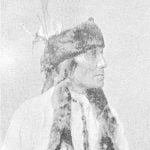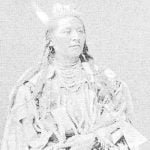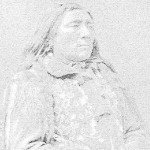Crow Agency

Report of Special Agent Walter Shiraw on the Indians of the Crow reservation, Crow agency, Custer County, Montana, July and August 1890.
Names of Indian tribes or parts of tribes occupying said reservation: 1 Mountain and River Crow.
The unallotted area of the Crow reservation is 1,712,960 acres, or 7,364 square miles, and was established, altered, or changed by treaty of May 7, 1868 (15 U. S. Stats., p. 649); agreement made June 12, 1880, and approved by Congress April 11, 1882 (22 U. S. Stats., p. 42), and agreement made August 22,1881, approved by Congress July 10, 1882 (22 11. S. Stats., p. 157); executive order December 7, 1886. The reservation has been partially surveyed.
Indian population 1890; Crows, 2,287.
Crow Agency, Montana
Crow Reservation

Crow agency is pleasantly located on the Little Horn River, 50 miles south of Ouster station, on the Northern Pacific railroad, in Custer County, Montana. The appearance of the soil on the Crow reservation is not promising at present, owing partly to the long drought. Irrigation is the great demand for the development of at least its 2 large valleys and their bottomlands, namely, the Big Horn and Little Horn. If the demands of the agency for the ditching of arable lands are complied with the cost will be not far from $200,000, but the increased value of lands thus reclaimed would warrant the outlay.
Continued drought, has this year even exceeded that of the past 2 years, and as long dry spells are characteristic of this climate irrigation becomes a necessity in fanning. The soil is deep and productive to a high degree. For grazing the native grass is excellent, and when sun cured holds its nutrition much better than the cultivated grasses, but large herds constantly feed upon it. Where the grass in former years stood from 2 to 3 feet high it is now a few inches, and the blades are fewer and far apart.
The reservation has sufficient irrigable laud to supply each individual with his allotment. Timber exists in sufficient quantity to meet all requirements for building. Coal of excellent quality abounds. A mine located 25 miles from the agency has been surface worked for home consumption.
Efforts in the way of farming have been without results this season, except along one ditch in the Little Horn valley. Few of the Indians will harvest crops equal in quantity to the seed planted. Several families located along the Little Horn ditch have raised small crops. Probably 30, bushels of wheat, 400 of oats, 40 of corn, 500 of potatoes, and 50 bushels or other vegetables will comprise the product, This ditch is a short one, only about 8 miles in extent, constructed in 1.885 at a cost of $7,400. Surveys have been authorized for another ditch 20 miles long.
Rich deposits of copper have been found in the western portion of the reservation; gold and silver also are found.
The Crow Indian labors under serious disadvantages with the old., discarded farming implements of the poorest quality with which he is provided, when in order to work advantageously he should have the very best. Furnished with water and good farming implements, this reservation can be made as productive as any valley in Montana; but without such only repeated failure can be anticipated, and naturally the Indian becomes discouraged and disgusted, and unless some change for the better is oracle soon, any agent will have an unpleasant task in inducing the Indians to continue their very imperfect labors in the direction of self-support.
The Indian is a natural herder; he desires to own his cattle, for the support of which the bench land affords excellent grazing, lying as it does adjacent to the fanning or bottomland. The Crows have an additional issue of stock cattle this year.
It is the aim of the agent to employ the Indians on every possible occasion, They earn several thousand dollars yearly from the government by freighting, which, added to their earnings from hay, tends to make .a fair total divided among the few who are the workers.
Rations are issued monthly and Semimonthly. Those receiving monthly rations live at a considerable distance from the agency. The Indian looks upon ration day as an outing, and many families consume the whole of their rations during their journey back to camp. All the labor attending the receiving of rations is performed by the squaws.

The agency is well supplied with all necessary offices and buildings for storing goods and supplies; blacksmith and carpenter shops are roomy and well furnished with tools, and the stable and barns are ample; but the school building is too small. One is met here by the perplexing problem of providing work for Indian students returning from Carlisle and other distant schools. A few may be employed about the agency, but most of them wander aimlessly about without means of support. Industrial education without an opportunity of applying its principles becomes a doubtful blessing to the Indian.
The agency police force, composed of a captain, 1 lieutenant, and 14 privates, is an excellent body of men (Indians), efficient and faithful.
The physique of the Crow Indian is remarkably fine, the men averaging 6 feet in height, with strong features, perceptive powers predominating. As a rule, the Crow dresses in half Indian costume, and has adopted no civilized way of living, preferring his tepee to the lint provided for him by the government.
Courtship and marriage are matters of inclination and barter. A stipulated number of ponies are exchanged with the father for the possession of the daughter. Marriage ties are not binding, the husband being allowed to return his squaw when weary of her. She may marry again. Plurality of wives is allowed. The Indians are extremely indulgent to their children, and quarreling among them is unknown. Syphilis prevails to an alarming extent, the result of contact with the whites, and abortion is common.
The religion of Crows is founded on innumerable legends, both material and sentimental. They believe in the coming of a messiah, who will fill the prairie anew with the buffalo and recreate the World for the benefit of the Indian,
The greatest obstacle in the way of civilizing these Indians is the “medicine man”, who works upon their superstition. They have a contempt for the agency physician and his medicine generally, with the exception of salves, which they use, somewhat; but it is a difficult matter to prescribe for them, as no attention is paid to the, directions.
Indian bends or sub-portions if the tribe are managed said controlled by chiefs, who, like barons or certain districts, have retainers and control them and their votes.
The Crows wrap their dead in blankets and deposit them in cliffs, on trees, or on high platforms, surrounded by their personal effects, and leave them thus exposed to dry and become absorber: by the elements.
As a class these Indians are peaceful in disposition and inclined to a pastoral life; at the same time they are stealthy and sly. The men often wrap themselves in a sheet or blanket, leaving but one eye exposed, and baffle any inquiry as to their identity or purpose in all money transactions they are very shrewd, and are called good traders and “superb horse thieves”, They are very rich in horses, imitation of form is characteristic of the Crows, but the faculty at, present is apparently limited to representing familiar forms in crude cut line or silhouette. They live on dried meats, berries, and water, do not care for flour, and frequently consume some one article of their entire rations at a single meal. They prefer living in tepees, each family having one, but there is no privacy. They are very social, friends coining in frequently and staying until everything is eaten. They give freely, demand alike in return, and never refuse anything that is offered them. Cleanliness is not one or their virtues.
The total number of Crow Indians is as follows:
Crow, including 80 half-bloods 2,287
Males 1,082
Females 1,205
Males over 18 years, 632
Females over 14 years of age 897
Children between 6 and 16 years of age 581
The births and deaths among the Crows about balance each other.
Most of the Crow Indians are engaged in agricultural pursuits. They have 350 wagons, 600 sets of harness, 50 mowing machines and horse rakes, 7 reapers, 300 harrows, and hundreds of sum all implements. They complain that the government dues not make the full issue of beef to them.
There are 3 good working schools on the Crow reservation: the Catholic, with 150 pupils; the Unitarian, with 50; and the Montana industrial, (boys 31,girls 29), a. total of 263 pupils. This number is out of a school population of 584. About 30 young Indians from this reservation are at Carlisle, and this year 10 pupils returned from that school, 6 boys and 4 girls, proficient in the industries of dressmaking and harness and wagon making. The agent desires the fostering of these industries on the reservation and expects help front these pupils. The usual number of children to the family is from 2 to 3. The classification of family relations is difficult, owing to the interchange and exchange of their squaws and papooses.
There are 33 public buildings at the Crow agency, Montana, all reported as in good repair, consisting of agent’s house, office, schoolhouse, dormitory, warehouse, carpenter shop, blacksmith shop, stables, slaughter house, laundry and bake room, dispensary, police, and interpreter’s quarters, and structures for other purposes. The cost of construction of these buildings was $43,311, and the present estimated value is $26,011.
Citations:
- The statements giving tribes, areas, and laws for agencies are from the Report of the Commissioner of Indian Affairs, 1890, pages 434-445. The population is the result of the census.[
]
